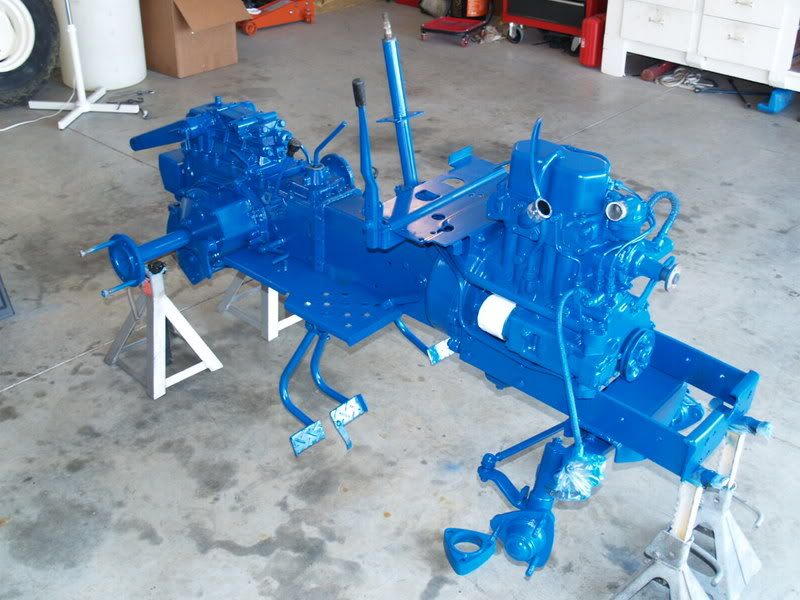Smoody
Platinum Member
I have researched this prior and read mixed reviews about the quality of a spray can paint job. I am in no way implying that this method is anywhere near as good as a good automotive paint, however those on a shoe string budget with a rusted tractor that really don't care to have a "show room" finish I thought I would share my experiences. I have not completed my project as I was skeptical, I painted one fender on my yanmar and it turned out great, I will post photos soon.
Material Used:
Rust-o-leum Heavy rust Primer - Brown
Rust-o-leum Automotive Wet/Dry Sand Primer - Grey
Rust-o-leum Professional Series Enamel - Regal Red - Gloss
Rust-o-leum Professional Clear Coat Enamel - Gloss
1st, I sanded all rusted areas down to the bare metal and put 3 coats of Rust-o-leum Heavy Rust primer on the area, waited to let dry, sanded.
2nd, I scuffed the original paint up a bit using 80 grit and cleaned entire fender using simple green degreaser.
3rd, I sprayed 3 coats of the automotive wet/dry primer, then sanded the entire area using 600 grit sandpaper between each coat! very important.
4th, I sprayed 1 really light coat of the regal red and let dry, sanded with 800 grit and applied 2nd coat at medium coverage, let dry then sanded again with 800 grit, finally I finished the 3rd coat at medium/heavy coverage and let dry.
5th, I waited 48 hours for the base coat to cure and then applied 4 coats of the clearcoat finish.
I have to say this thing looks great, extemely shiny. I don't know how well it will resist fading I guess time will tell. I do however believe you can achieve great results if your patient and put in the proper prep work, which is 90% of the outcome.
Caution - Please wear proper safety equipment and work in a well ventilated area! I am not sure but I bet the original yanmar paint was a lead base and sanding that will release lead into the air and it can cause all sorts of lung issues even resulting in death.
TIP
Follow Manufacturer recoat times and use the same brand as it may chemical react with others.
I am not a professional so results may vary! I just seen alot of topics on this and thought I would share my own personal experience.
Material Used:
Rust-o-leum Heavy rust Primer - Brown
Rust-o-leum Automotive Wet/Dry Sand Primer - Grey
Rust-o-leum Professional Series Enamel - Regal Red - Gloss
Rust-o-leum Professional Clear Coat Enamel - Gloss
1st, I sanded all rusted areas down to the bare metal and put 3 coats of Rust-o-leum Heavy Rust primer on the area, waited to let dry, sanded.
2nd, I scuffed the original paint up a bit using 80 grit and cleaned entire fender using simple green degreaser.
3rd, I sprayed 3 coats of the automotive wet/dry primer, then sanded the entire area using 600 grit sandpaper between each coat! very important.
4th, I sprayed 1 really light coat of the regal red and let dry, sanded with 800 grit and applied 2nd coat at medium coverage, let dry then sanded again with 800 grit, finally I finished the 3rd coat at medium/heavy coverage and let dry.
5th, I waited 48 hours for the base coat to cure and then applied 4 coats of the clearcoat finish.
I have to say this thing looks great, extemely shiny. I don't know how well it will resist fading I guess time will tell. I do however believe you can achieve great results if your patient and put in the proper prep work, which is 90% of the outcome.
Caution - Please wear proper safety equipment and work in a well ventilated area! I am not sure but I bet the original yanmar paint was a lead base and sanding that will release lead into the air and it can cause all sorts of lung issues even resulting in death.
TIP
Follow Manufacturer recoat times and use the same brand as it may chemical react with others.
I am not a professional so results may vary! I just seen alot of topics on this and thought I would share my own personal experience.

